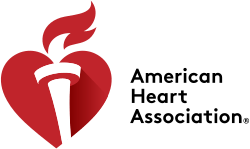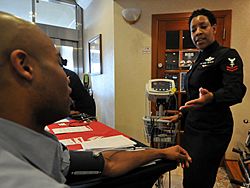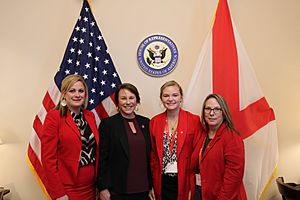American Heart Association facts for kids
 |
|
| Formation |
|
|---|---|
| Founder | Paul Dudley White (Co-Founder) |
| Type | Nonprofit |
| Purpose | "Building healthier lives, free of cardiovascular diseases and stroke" |
| Headquarters | 7272 Greenville Avenue Dallas, Texas 75231-4596 United States |
|
Key people
|
Joseph Ching-Ming Wu (President) |
The American Heart Association (AHA) is a nonprofit organization in the United States that funds cardiovascular medical research, educates consumers on healthy living and fosters appropriate cardiac care in an effort to reduce disability and deaths caused by cardiovascular disease and stroke. They are known for publishing guidelines on cardiovascular disease and prevention, standards on basic life support, advanced cardiac life support (ACLS), pediatric advanced life support (PALS), and in 2014 issued the first guidelines for preventing strokes in women. The American Heart Association is also known for operating a number of highly visible public service campaigns starting in the 1970s, and also operates several fundraising events.
Originally formed in New York City in 1924, the American Heart Association is currently headquartered in Dallas, Texas. The American Heart Association is a national voluntary health agency. The mission of the organization, updated in 2018, is "To be a relentless force for a world of longer, healthier lives." The organization's work can be divided into five key areas: research; heart and brain health; health equity; advocacy; and professional education and development.
Contents
History
1924–1980s
In 1924, six cardiologists Paul Dudley White, Hugh D. McCulloch, Joseph Sailer, Robert H. Halse, Robert B. Preble, Lewis A. Conner, formed the Association for the Prevention and Relief of Heart Disease as a professional society for doctors. In 1948, the organization transitioned into a nationwide voluntary health organization. Since 1949, it has funded over $5 billion in cardiovascular, cerebrovascular, and brain health research. The organization, now known as the American Heart Association, consists of over 33 million volunteers who are dedicated to improving heart health and reducing deaths from cardiovascular diseases.
In the 1950s and 1960s, the American Heart Association published several reports and guidelines focused on recommended lifestyles to improve cardiovascular health. This included a 1957 report that said: (1) Diet may play an important role in the pathogenesis of atherosclerosis, (2) The fat content and total calories in the diet are probably important factors, (3) The ratio between saturated and unsaturated fat may be the basic determinant, and (4) A wide variety of other factors besides fat, both dietary and non-dietary, may be important.
By 1961, these findings had been strengthened, leading to the new 1961 American Heart Association recommendations: (1) Maintain a correct body weight, (2) Engage in moderate exercise, e.g., walking to aid in weight reduction, (3) Reduce intake of total fat, saturated fat, and cholesterol. Increase intake of polyunsaturated fat, (4) Men with a strong family history of atherosclerosis should pay particular attention to diet modification, and (5) Dietary changes should be carried out under medical supervision. These recommendations continued to become more precise from 1957 to 1980, but there maintained "a general coherence among them".
1990s–2000s
In 1994, the Chronicle of Philanthropy, an industry publication, released the results of the largest study of charitable and non-profit organization popularity and credibility. The study showed that the American Heart Association was ranked as the fifth "most popular charity/non-profit in America" of over 100 charities researched with 95 percent of Americans over the age of 12 choosing the Love and Like A lot description categories.
In 1998, the AHA created the American Stroke Association to help prevent strokes, improve treatments, and maximize recoveries. In 2003, the two organizations created the Get With the Guidelines (GWTG)-Stroke program. It is a voluntary registry that hospitals can use to receive the latest scientific treatment guidelines. The program also collects data on patient characteristics, hospital adherence to guidelines, and patient outcomes.
In 2004 the American Heart Association launched the "Go Red for Women" campaign specifically targeting women, with information about risks and action they can take to protect their health. All revenues from the local and national campaigns go to support awareness, research, education and community programs to benefit women.
In 2008, the AHA recommended “hands only” CPR as an option for bystanders who want to help keep a cardiac arrest victim alive. This method removes the practice of performing rescue breaths and depends solely on chest compressions.
On November 30, 2009, The American Heart Association announced a new cardiac arrest awareness campaign called Be the Beat. The campaign's aim is to teach 12- to 15-year-olds fun ways to learn the basics of cardiopulmonary resuscitation and how to use an automated external defibrillator.
2012–present: Recent events and activities
In 2012, the AHA renewed its focus on hands-only CPR by carrying out a national campaign to educate more people on how to perform this method. Jennifer Coolidge was a spokesperson for the campaign.
It also carried out a campaign in 2012 to educate more people on how to carry out hands-only CPR. The 2012 campaign, which began in New York City, had Jennifer Coolidge as the spokesperson.
In 2013, the American Heart Association issued a joint guideline recognizing obesity as a disease and recommending its treatment by weight loss.
In 2014, the American Heart Association issued its first guidelines for preventing strokes in women. Just as heart attack systems differ between men and women, men and women also face different stroke risks. For women, the guidelines for preventing strokes focus on factors such as pregnancy, and depression.
In 2015, the American Heart Association officially endorsed the Tobacco 21 campaign, urging local, state and national governments to raise the tobacco and nicotine sales age from 18 to 21.
In 2016, the American Heart Association, Verily Life Sciences, and AstraZeneca invested $75 million in the One Brave Idea program. The money was awarded to institutions researching new biomarkers, such as genetic and molecular factors, that put individuals at risk for atherosclerosis. It was hoped that the research would help the AHA reach its goals of increasing cardiovascular health by 20% and reducing cardiovascular mortality by 20% by 2020.
In 2017, the American Heart Association, the American College of Cardiology, and nine other groups redefined high blood pressure for the first time in fourteen years. Under the new guidelines, the high blood pressure reading is 130 over 80, a change from the old 140 over 80. The change was made in recognition of the risk of heart disease, disability, and death faced by those with blood pressures at 130 over 80.' The organization said that they hoped by identifying cardiovascular risks earlier, more people would be able to address the health risks by lifestyle changes instead of medication.'
In 2018, the American Heart Association and American College of Cardiology issued new guidelines for clinicians on the management of cholesterol as a way to reduce risk for heart attack and stroke. Newly included in the guidelines is a recommendation to use coronary artery calcium score if healthcare providers are having difficulty deciding if a patient could benefit from statin medications or should focus solely on lifestyle modifications. The cholesterol guidelines were last updated in 2013.
In 2020 and 2021, the annual flagship meeting of the organization was held virtually owing to the COVID-19 pandemic and resumed as an in-person conference in 2022.
Focus areas
Some of the American Heart Association's research, campaigns, and other work is included here.
Research
Since 1949, the association has funded over $5 billion in cardiovascular, cerebrovascular, and brain health research.
Strategically Focused Research Network (SFRN)
In 2014, the American Heart Association announced the Strategically Focused Research Network initiative to address "key strategic issues as determined by the AHA Board of Directors." Some of the topics focused on by SFRNs include hypertension, heart failure, heart disease, and health technologies and innovation.
Heart and brain health
Go Red for Women
The Go Red for Women campaign started in 2004 to raise awareness that women, and not only men, are vulnerable to heart disease. Between 2016 and 2021, the American Heart Association invested $20 million in the Go Red for Women Strategically Focused Research Network. The SFRN also received $52 million from the National Institutes of Health.
In 2017, the Go Red National Leadership Council was started to engage female executives in the campaign. Additional projects associated with the campaign include Research Goes Red and National Wear Red Day.
As of 2023, over 900,000 women have joined the campaign and receive updates on what they can do to improve their heart health. The campaign's social media channels had audiences of over 5.3 million in 2022.
Be the Beat
The "Be the Beat" challenge encourages people to learn CPR.
American Heart Association CEO Roundtable
The CEO Roundtable was formed in 2013 and focuses on implementing evidence-based approaches to workplace health. In 2020, the CEOs of CVS Health, Walgreens Boots Alliance, and US Foods joined the association. In 2023, there were almost 50 Fortune 100 CEOs in the association.
American Stroke Association
In 1998, the association created the American Stroke Association to help prevent strokes, improve treatments, and maximize recoveries. In 2003, the two organizations created the Get With the Guidelines (GWTG)-Stroke program. It is a voluntary registry that hospitals can use to receive the latest scientific treatment guidelines. The program also collects data on patient characteristics, hospital adherence to guidelines, and patient outcomes.
R.A.P.I.D.O. Campaign
This 2023 Spanish-language campaign works to raise awareness among Hispanic Americans about stroke symptoms. The acronym stands for:
- Rostro caído (face drooping)
- Alteración del equilibrio (loss of balance or lack of coordination)
- Pérdida de fuerza en el brazo (arm weakness)
- Impedimento visual repentino (sudden vision difficulty)
- Dificultad para hablar (slurred or strange speech)
- Obtén ayuda, llama al 911 (get help, call 911)
Know Diabetes By Heart
This is a joint campaign from the American heart Association and the American Diabetes Association. It works to raise awareness about the connection between diabetes and heart disease. The AHA reports that adults with diabetes are 2-4 times more likely to die from heart disease than adults without diabetes.
Check. Change. Control.
The "Check. Change. Control." program is an evidence-based hypertension management program that encourages blood pressure self-monitoring. In 2019 it was used by more than 315,000 people.
Nation of Lifesavers
This program was started in 2023 to “educate and prepare teens and adults to be confident to save life in a cardiac emergency.” More than 350,000 people have out-of-hospital cardiac arrests each year, and this program wants to help improve their survival rate.
Life’s Essential 8
Life’s Essential 8 (LE8) are cardiovascular health measurements shared by the AHA. Previously the measurements were known as the LE7, but in 2022, the AHA added sleep health as an additional behavioral metric. The other metrics look at body weight, blood pressure, cholesterol, blood sugar, smoking, physical activity, and diet.
Health equity
The American Heart Association’s 2024 Impact Goal states, "Every person deserves the opportunity for a full, healthy life. By 2024, as champions for health equity, the American Heart Association will advance cardiovascular health for all, including identifying and removing barriers to health care access and quality."
The AHA partnered with the Deloitte Health Equity Institute and the Society for Human Resource Management Foundation on the Health Equity in the Workforce initiative. The initiative provides tools to help employers improve health equity in the workplace.
Social Impact Fund
The AHA's Social Impact Fund is a nationwide fund that provides financial resources for "evidence-based, community driven entrepreneurial solutions that help remove the social and economic barriers to health equity and drive economic empowerment, healthy food access, affordable housing, access to quality healthcare, transportation, educational opportunities, and reduce recidivism."
Organizations that have received funding include:
- Sakan Community Resource
- Hmong American Farmers Association
- Better Futures Minnesota
- Sidekick Mobile Technologies
- Sweet Potato Patch
Hispanic Serving Institution Scholars Program
The HSI scholarship program is for students who identify as Hispanic/Latino who are enrolled in public health and healthcare focused programs at 18 Hispanic-serving colleges and universities. The program's goal is to increase representation in health care. Students in the program are paired with volunteer mentors. They develop and present a research project that addresses basic, clinical, and educational science, receive a stipend, and participate in professional development workshops.
Historically Black Colleges and Universities Scholars Program
The HBCU Scholars program pairs students with a local American Heart Association researcher and was created to "support the development of minority scientists and healthcare professionals," and increase the number of minority students who apply and are accepted into biomedical and health science programs. Students and researchers study the impact of cardiovascular disease in their community, learn the factors affecting vulnerable populations, and sample areas of scientific inquiry. Students also receive financial stipends.
HeartCorps
HeartCorps is the American Heart Association's Public Health AmeriCorps program and is designed to drive health equity in rural America. As of November 2022, twenty-six states participated in the program.
Advocacy
No Surprise Medical Billing
The American Heart Association supports the No Surprises Act, stating it will keep costs and premiums down and encourage more people to seek care from healthcare professionals.
Food is Medicine Research Initiative
In 2022, the American Heart Association, the Rockefeller Foundation, Kroger, and other partners announced a plan to build a national Food is Medicine Research Initiative to help provide concrete evidence that food-as-medicine programs improve health.
In September 2023, the AHA partnered with the National Association of Chain Drug Stores, the American Cancer Society, the American Diabetes Association, and the Food is Medicine Institute at the Friedman School of Nutrition Science and Policy at Tufts University to launch Nourish My Health. It is a national public education campaign that promotes the protective health benefits of nutritious food.
You're the Cure
You're the Cure is the national grassroots network of the American Heart Association.
Professional education and development
The American Heart Association publishes healthcare guidelines, statements, and performance measures.A small sample of these professional education and development resources include:
- Information to prevent strokes, improve treatments, and maximize recoveries
- Lifestyle recommendations to improve cardiovascular health
- Guidelines to prevent strokes in women
- High blood pressure definitions
- Management guidelines to reduce cardiovascular risk factors in adults with Type 2 diabetes
- Scientific statements on specific diseases
- Care guidelines for cardiovascular attacks
- Scientific statements looking at specific healthcare practices, such as shared decision-making
The AHA also holds an annual Scientific Sessions meeting, which covers several days and a number of medical/healthcare topics; and hosts an International Stroke Conference.
Second Century of Science Initiative
The Second Century of Science Initiative was announced in 2023 as part of the AHA’s plans to celebrate its first 100 years. Under the Initiative, the AHA awarded $20 million in grants to over 100 scientists in the U.S. The grants were awarded in three categories: the Second Century Implementation Science Award, the Second Century Early Faculty Independence Award, and the Clinical Fellow Research Education Program
Get With the Guidelines
In 2003, the AHA and the American Stroke Association created the Get With the Guidelines (GWTG)-Stroke program. It is a voluntary registry that hospitals can use to receive the latest scientific treatment guidelines. The program also collects data on patient characteristics, hospital adherence to guidelines, and patient outcomes.
Fellowship
Fellowship is open to wide-ranged medical professionals (physicians, scientists, etc.) who demonstrate a major and productive interest in cardiovascular diseases and stroke. The association has 16 different councils. Members (at the Premium Professional or Premium Professional Plus level) of one of these councils can apply for Fellowship. All applicants from all councils will be evaluated against the same criteria. Fellows are entitled to use the post-nominal designation FAmerican Heart Association (Fellow of the American Heart Association), which reflects not only the professional stature of the Fellow but also their record of valuable service to the association and the council. In addition, American Heart Association fellowship offers several benefits; e.g., reduced subscription rates for all American Heart Association print journals and reduced registration fees for American Heart Association Scientific Sessions.
Key people
Nancy Brown is the CEO of the American Heart Association. Joseph Wu is the volunteer president and Marsha Jones is the volunteer chairperson. Nancy Brown has been the chief executive officer since 2009.
See also
 In Spanish: Asociación Estadounidense del Corazón para niños
In Spanish: Asociación Estadounidense del Corazón para niños
- American College of Cardiology
- American Heart Association Paul "Bear" Bryant Awards
- American Heart Month
- Automated external defibrillator (AED)
- American Stroke Association




